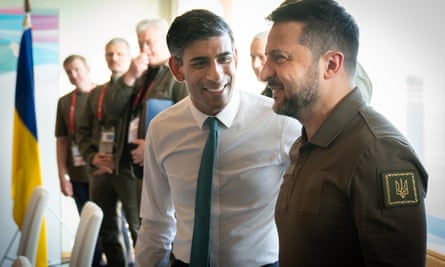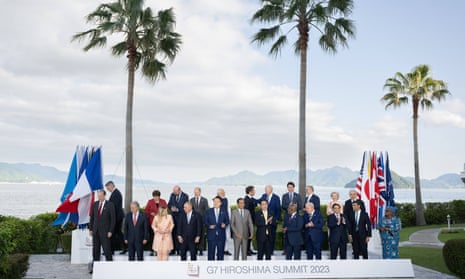Rishi Sunak said Volodymyr Zelenskiy’s appearance at the G7 summit in Japan sent an “incredibly powerful message” to Russia that western leaders are behind him, as the UK indicated it would start training Ukrainian fighter pilots to fly F-16s within the next couple of months.
The Ukrainian president arrived in Hiroshima on a French government plane on Saturday to discuss greater military support from the US and other G7 countries as his forces prepare for a huge counteroffensive in the war with Russia.
Sunak noted that the G7 had once been the G8, before Russia was expelled in 2014 for its illegal annexation of Crimea and “flagrant abuse of human rights and the rule of law”.
He added: “Nine years on, it sends an incredibly powerful message to have my friend and Ukraine’s President Zelenskiy with us in Hiroshima today. It tells the world that the G7 stands united with the people of Ukraine, in the face of a terrible onslaught. And it demonstrates that brute force and oppression will not triumph over freedom and sovereignty.

“I am delighted that the G7 has agreed on the importance of giving President Zelenskiy the advanced military equipment needed to win this war and prosper as a free and democratic nation.”
UK sources said it was Sunak’s suggestion Zelenskiy should come to the G7 to make his case in person, adding that he had made this proposal in a phone call about a month ago.
Sunak’s official spokesperson said: “It is an opportunity for President Zelenskiy to address a lot of world leaders in one place at a time when western leaders are aligned.”
In his first face-to-face meeting with Narendra Modi, who has called for a ceasefire but not condemned Russia, Zelenskiy briefed the Indian prime minister on Ukraine’s peace plan, which calls for the withdrawal of Russian troops from the country before negotiations can start.
Zelenskiy later said he had asked Modi to help implement the peace plan. “I spoke about Ukraine’s needs in humanitarian demining and mobile hospitals,” Zelenskiy tweeted. “I thank India for supporting our country’s territorial integrity and sovereignty, in particular, at the platforms of international organisations, and for providing humanitarian aid to Ukraine.”
In their final communique – released a day earlier than expected – the G7 leaders reaffirmed their support for Ukraine.
“Russia’s brutal war of aggression represents a threat to the whole world in breach of fundamental norms, rules and principles of the international community,” it said. “We reaffirm our unwavering support for Ukraine for as long as it takes to bring a comprehensive, just and lasting peace.”
Zelenskiy’s arrival in Hiroshima comes a day after the White House announced it would permit allied countries to supply Ukraine with US-built F-16 fighter jets.
Before leaving for Japan, Zelenskiy described the decision ashistoric, adding that he looked forward to “discussing the practical implementation” with G7 countries.
The White House said Joe Biden was looking forward to meeting Zelenskiy at the summit, with the US national security adviser, Jake Sullivan, saying it was a “safe bet” that the pair would meet. “The president looks forward to the opportunity to be able to sit down face to face,” he said.
With the US veto on F-16s lifted, Sunak announced that Britain would work together with the US and the Netherlands, Belgium and Denmark to get Ukraine the combat air capability it needs.
Japan is the farthest Zelenskiy has travelled to make the case for more military aid, and comes after visits to Italy, Germany, France and Britain.
He was in Saudi Arabia to attend the Arab League summit before heading to Hiroshima, where he is expected to take part in two separate sessions on Sunday – one with G7 members and another focusing on “peace and stability” with non-G7 countries taking part in the Hiroshima summit.
That will give him a rare opportunity to speak to the leaders of powerful non-aligned countries, including Brazil, who have declined to condemn Russia’s invasion.
Amid concerns over Russia’s refusal to rule out the use of tactical nuclear weapons in Ukraine, Zelenskiy is expected to visit a museum devoted to the horrors of the US atomic bombing of Hiroshima in August 1945 and a memorial to the hundreds of thousands of people who died as a result of the attack.
In their communique, the G7 leaders said they were committed “to achieving a world without nuclear weapons with undiminished security for all, through taking a realistic, pragmatic, and responsible approach. We reaffirm the importance of disarmament and non-proliferation efforts to create a more stable and safer world.”
The International Campaign to Abolish Nuclear Weapons condemned the statement as a rehash of proposals that had “failed to deliver progress over the past three decades”.
“They did not announce any new, concrete measures,” it said in a statement, adding: “What is needed from the G7 is responsible leadership to respond to the acute danger that nuclear weapons could be used in conflict for the first time since 1945, but rather than this, we heard criticism of Russia, North Korea and China which, while justified, evaded the G7’s own responsibility for the current threat nuclear weapons pose to everyone.”
